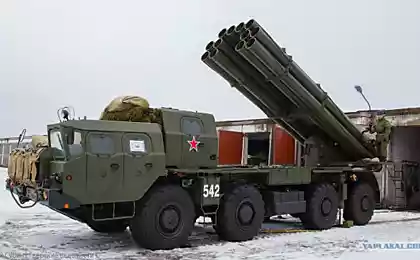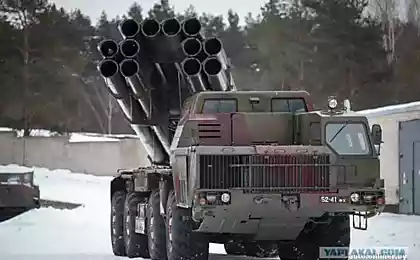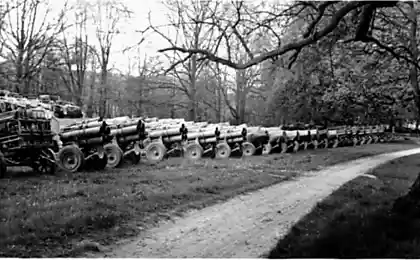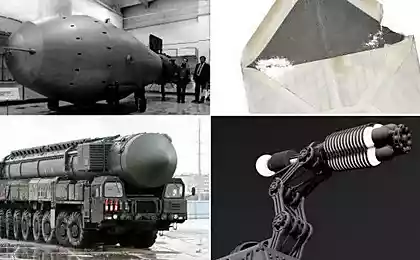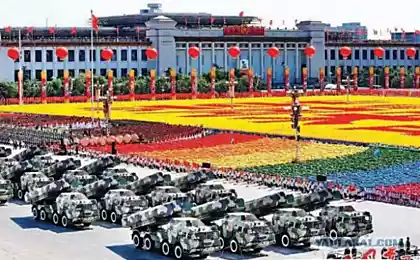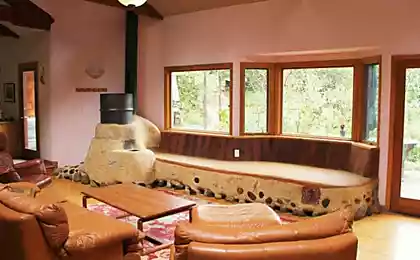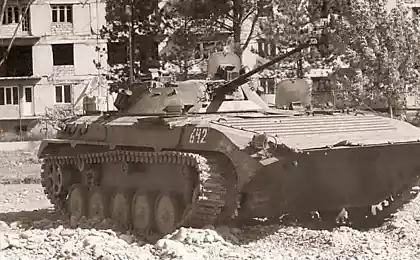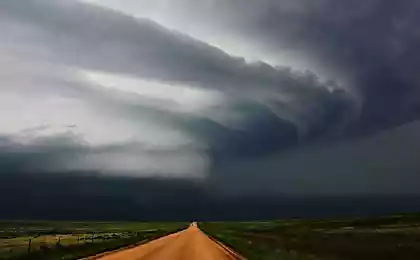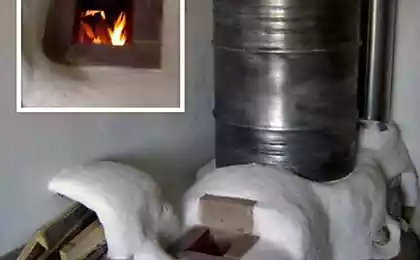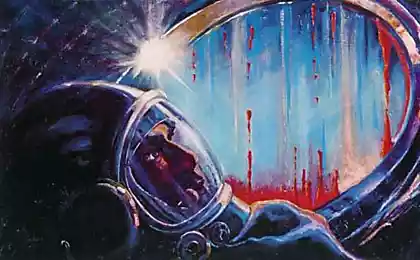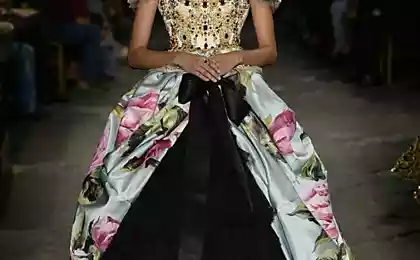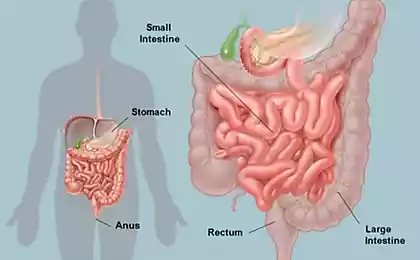1235
MLRS 9K58 "Smerch" -reaktivnaya long-range system
The second time that day I find interesting articles about arming Russia and the continuation of the theme of the PTRC "Iskander" I want to share with you about the MLRS 9K58 "Smerch", on Yap has raised the issue of it, but I think it was interesting to find out more (TTX) on This class of weapons.
The system "Smerch" is rated as the most powerful MLRS of the world. Its purpose - to defeat manpower, combat vehicles, fortifications and troops control points at distances of 20 to 70 km. The system was developed in the early 1980s SSPE "Alloy" in collaboration with more than 20 other companies, and the Soviet Union in 1987, adopted by the Soviet Army. Currently MLRS "Smerch" is in service with the armies of Russia, Ukraine, Belarus, Kuwait and the United Arab Emirates. Interest in purchasing the system was shown by representatives of India and China.
Will 9 photos + text (description) + one video
Source took away
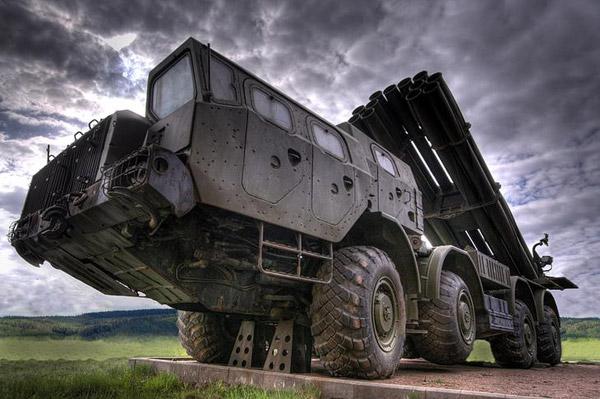
MLRS 9K58 "Smerch" 9A52-2 includes launcher, 300-millimeter rockets, fire control system, transport and loading vehicle 9T234-2, training aids, and the Arsenal complex equipment. Launcher consists of an artillery unit and four-car chassis with high cross MA3-543M. Layout - a classic. Artillery unit is mounted at the rear wheel chassis, front left are the driver's cab, the engine-transmission compartment and cockpit, which are mounted radio communications equipment and fire control system.
The structure of the artillery of the package consists of 12 tubular rails, swivel base, lifting, turning and balancing mechanisms, sights, power and accessories. The guide is a smooth-tube fitted with a screw U-shaped groove for the promotion of shells. Mechanisms for targeting via actuators suggest package guides in a vertical plane in the range of angles from 0 ° to + 55 °. Horizontal firing angle is 60 ° (30 ° left and right of the machine axis). Between the third and fourth wheels mounted hydraulic bridge pillars on which are hung aft launcher to increase its stability when shooting.
Designed SSPE "Alloy" for MLRS "Smerch" missiles have a unique design that provides precision hitting in the 2-3 times higher than foreign systems. The shells are equipped with flight management system, correcting the trajectory of the pitch and yaw. Correction is carried out gasdynamic rudders operated by high pressure gas from the gas generator onboard.
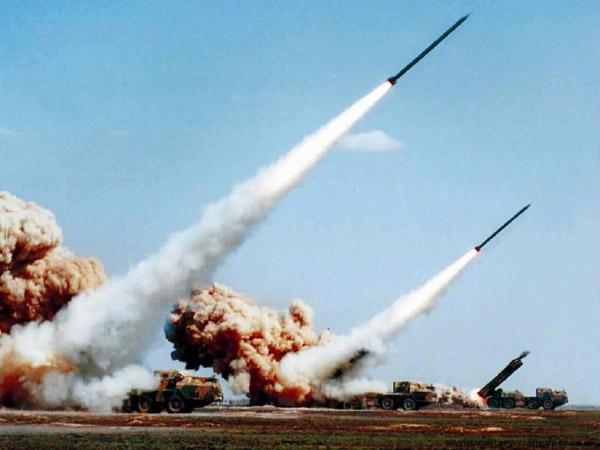
In addition, the stabilization of the projectile in flight is due to rotation around its longitudinal axis to provide initial promotion while the extensions of the tubular guide and supported in flight by installing drop stabilizer blades at an angle to the longitudinal axis of the projectile. When firing a volley of shells dispel this design does not exceed 0, 21% of the firing range.
300-mm shells MLRS "Smerch" are equipped with solid-jet composite propellant, they have a length of 7, 5 m and weight of 800 kg. Weight warhead - 280 kg. It can be one-piece or tape.
The following types of ammunition:
■ high-explosive shells 9M55F a single warhead (the weight of the explosive was 92, 5 kg bomb used to destroy fortifications, points of control of troops, missile launching sites, etc.);
■ shell 9M55K with cassette warhead containing 72 submunitions fragmentation type 2 kg each (the main purpose of the projectile - the defeat enemy personnel, 10-16 such missiles is sufficient to guarantee the destruction of motorized infantry company);
■ shell 9M55K1 with cassette warhead containing five high performance homing ammunition "Motive" (four machines volley firing such projectiles affected tank company in the area of concentration).
In recent years, was a complex "Smerch-M" with the combat vehicle chassis 9A52-2 M A3-543- A1 and transport-charging machine 9T234-2 on the same chassis. Developed family of missiles with a range increased to 90 km by implementing a set of measures similar to those taken by increasing the range of the modernized system "Grad" up to 35-40 km. primarily related to the improvement of the engine.
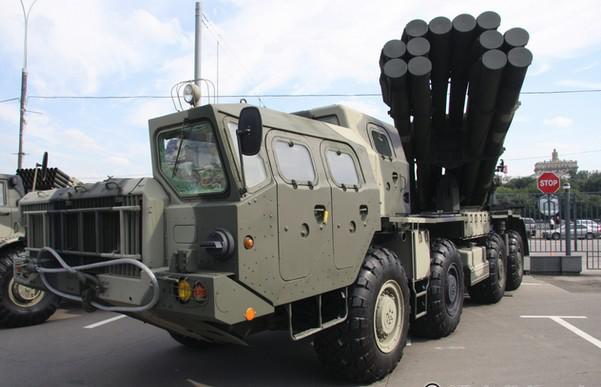
By the newly developed products, according to the reference book Jane's, include the following:
■ 9M525 missile with submunitions, completed 72 submunitions weighing 1, 75 kg;
■ 9M526 missile with submunitions equipped with five combat self-sighting elements with dual-band infrared focal points;
■ 9M527 missile with submunitions equipped with 25 anti-tank mines on the weight of 4 to 8 kg;
■ 9M528 missile weighing 815 kg with a one-piece high-explosive warhead fitted with a charge of 95 kg;
■ 9M529 missile with a thermobaric warhead monoblock containing 100 kg of body-detonating filler;
■ 9M530 missile with high-explosive penetrating warhead;
■ 9M531 missile with cluster warhead with 646 submunitions with armor-piercing 120mm.
Along with the use of missiles systems "Smerch" "and" Smerch-M "as a weapon to hit targets in the appropriate modifications they can be used as a delivery vehicle to the object of exploration disposable unmanned aircraft F-90, developed in the Kazan Research Center" ENIKO and often exhibited at airshows, starting with the MAX-93. Unmanned spy apparatus is equipped with a television, a satellite navigation system, the means of transmission of television information on a range of up to 70 km. Unmanned aerial vehicle equipped with Pulsejet and disclosed after separating tandem wings of high aspect ratio. UAV is capable of programming a reconnaissance flight for up to an hour at a speed of up to 145 km / h.

MLRS "Smerch" may be firing single rounds or in one gulp. Full volley war machine is made for 38 seconds. Launching missiles provided from the cockpit combat vehicle, or using the keypad. Power plants volley three MLRS "Smerch" in its effectiveness equals "work" two brigades, the armed missile systems 9K79 "Tochka-U". Volley one machine covers the area of 672,000 m2. High combat efficiency of MLRS "Smerch" is provided through the use of automated fire control system "Vivarium", developed and produced by Tomsk production association "Contour".
This system has the following principles:
■ simplicity, compactness and high reliability of the equipment;
■ autonomy and mobility elements of the system;
■ hardware and software compatibility with existing and future automation of field artillery fire;
■ possibility to operate in all environmental conditions and in a wide temperature range (from - 50 ° C to 40 ° C).
Management System "Vivarium" was put into service in the early 90s and became widespread. It is designed for automated and non-automated control MLRS brigade armed with complex 9K58 "Smerch", as well as 9K57 "Hurricane." Its technical facilities enable communications with superiors, subordinates and cooperating governments, solve the problems of planning concentrated fire and fire on the columns, prepares data for firing, collecting and analyzing information on the state of artillery units.

The basis of the management system "Vivarium" make command and staff vehicles (CSV) at the disposal of the commander and chief of staff of the brigade, as well as their subordinate commanders of divisions (up to three) and batteries (eighteen). The equipment is located in CSV vans K1. 4310 installed on the chassis of KAMAZ-4310. It includes communications, equipment classify data, digital computer displays and printers. The main technical means to solve the settlement problem is on-board digital computer E-715-1.1. Its performance for the combined mode is 500,000 short transactions to misalignment - 250 000. The amount of RAM - 96, non-volatile memory - 288 KB.
In SHKM all control points Brigade, a special mathematical and software, which provides:
■ receipt, processing, storage, display and formation of messages in a formalized and unstructured forms;
■ transmission links to higher management position reporting and readiness of each unit, to bring to the subordinate units and teams for training impacts;
■ protection of stored and processed data from unauthorized access staff and officials, as well as the unauthorized use of input-output.
All design challenges caused by the decision of a command entered by the operator in a specialized digital computer using remote control ATSD. The exception is the problem of calculating the control data on the goals that are solved automatically when receiving messages indicating the striking artist who has been called to deliver a volley.
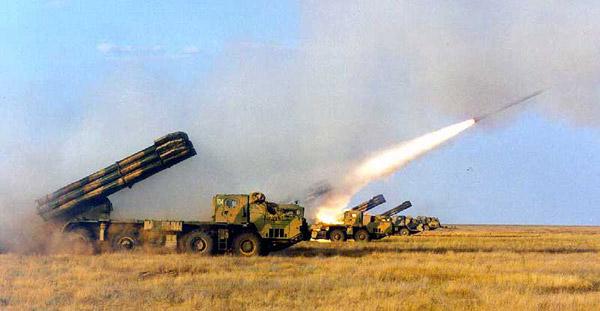
To monitor the process of solving problems in the workplace commander and operators crank mounted display device such as a television. Communication presents a set of VHF and HF radio, the radio allows you to confidently lead in the movement up to 50 km, and in the parking lot - 350 km. Body-van is equipped with antenna devices, providing reliable operation of radio stations. Radiotelephony carried out both from the cab and from the operational equipment compartment through T-240D. If necessary, it is possible for a few seconds will automatically switch to the backup channel, which virtually eliminates the loss of information during transmission. Exchange of data in motion is not provided.
Complex communications provides an interface and access to the following channelization means: the station of satellite, tropospheric and microwave transmission, HF and VHF stations, average power, communication hardware components, wired link. Power supply all the equipment on site, and the movement is carried out by transportable diesel power ED2h8-T400-18PS. To ensure the normal working conditions of the commander and operators in CSV air conditioning, filtering unit FVUA-10OP-24 and OV-heating systems 65G. The kit includes machines for the primary degassing DK-4D, devices of chemical and radiation reconnaissance, as well as spare parts. It should be noted that all command and staff vehicles belonging to the control system "Vivarium", have the same type equipment and in case of failure of one of them, its functions can be assigned to any other. This significantly improves system survivability during combat operations.
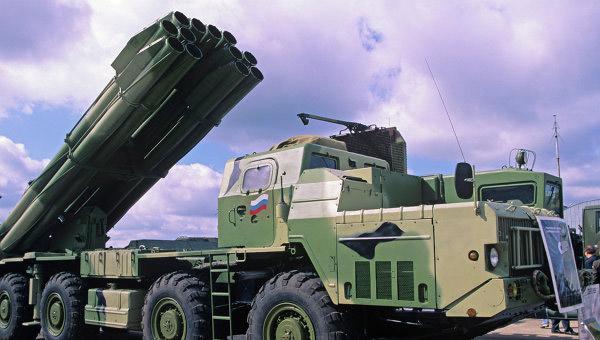
Operation can be clearly presented to the exemplary embodiment of combat use. At the command post of the brigade commander of the reconnaissance vehicle, as well as from higher authorities received information about the enemy. Computing means the commander and chief of staff of the brigade solve the problems of planning fire. At the same time estimated the possibility of fire departments, munitions, chosen method of defeats the purpose, determined by the density of fire, developed a variety of solutions to this problem. Then, automatically via the communication channels necessary data and orders are sent to the command post for one of the selected fire mission solutions divisions.
At the command post of the battalion commander clarifies information about the enemy (the nature, type and location purposes), solved the problem of survey, prepared by the meteorological bulletins according to the automated systems of meteorological intelligence. After that, on the basis of operative information about the location and readiness of subordinate units of battalion commander at their command centers of communication channels is transferred to the necessary information. Computational tools battery crank handle the information and form a flight mission for six armored MLRS "Smerch". According to Russian military experts, the automated control system "Vivarium" significantly increases the combat readiness of the units equipped with systems "Smerch", accuracy, and efficiency of the fire. It is not inferior to similar American ACS "Takfayr", and on a number of important indicators, such as the time of preparation for the battle and bringing teams exceed it in several times.

For the loading of the launcher MLRS 9K58 "Smerch" is the transport and loading vehicle 9T234-2 developed on the chassis MA3-543A. This machine has crane equipment and transports twelve rounds. The process of loading the launcher mechanized and runs for 35 minutes. Used to create the launcher and the transport and loading vehicle chassis have almost the same design and are equipped with a V-shaped twelve-diesel engine D12A-525a power of 525 hp (at 2000 rev / min). Transmission - hydromechanical, with torque converter and planetary three-gearbox with automatic switching. Chassis is made of a wheel formula 8x8. Governors is two front pair of wheels.
The suspension of all wheels - independent, torsion bar. On wheels mounted wide-tire air pressure is regulated by a centralized system (with the air supply through a pin and hub). When driving on the highway the car develops a maximum speed of 60 km / h, they can move on the roads of all categories and beyond, overcoming steep climbs to 30 ° and fords depth of 1 meter. Cruising range is 850 km. In general MLRS 9K58 "Smerch" has a very high combat efficiency. A volley of MLRS allows engagement of targets in the area of 67 hectares (670 000 square meters!).
So in conclusion, according to tradition an interesting video about this, to represent the system in action
That's all, thank you for your attention !!!

Source:
The system "Smerch" is rated as the most powerful MLRS of the world. Its purpose - to defeat manpower, combat vehicles, fortifications and troops control points at distances of 20 to 70 km. The system was developed in the early 1980s SSPE "Alloy" in collaboration with more than 20 other companies, and the Soviet Union in 1987, adopted by the Soviet Army. Currently MLRS "Smerch" is in service with the armies of Russia, Ukraine, Belarus, Kuwait and the United Arab Emirates. Interest in purchasing the system was shown by representatives of India and China.
Will 9 photos + text (description) + one video
Source took away

MLRS 9K58 "Smerch" 9A52-2 includes launcher, 300-millimeter rockets, fire control system, transport and loading vehicle 9T234-2, training aids, and the Arsenal complex equipment. Launcher consists of an artillery unit and four-car chassis with high cross MA3-543M. Layout - a classic. Artillery unit is mounted at the rear wheel chassis, front left are the driver's cab, the engine-transmission compartment and cockpit, which are mounted radio communications equipment and fire control system.
The structure of the artillery of the package consists of 12 tubular rails, swivel base, lifting, turning and balancing mechanisms, sights, power and accessories. The guide is a smooth-tube fitted with a screw U-shaped groove for the promotion of shells. Mechanisms for targeting via actuators suggest package guides in a vertical plane in the range of angles from 0 ° to + 55 °. Horizontal firing angle is 60 ° (30 ° left and right of the machine axis). Between the third and fourth wheels mounted hydraulic bridge pillars on which are hung aft launcher to increase its stability when shooting.
Designed SSPE "Alloy" for MLRS "Smerch" missiles have a unique design that provides precision hitting in the 2-3 times higher than foreign systems. The shells are equipped with flight management system, correcting the trajectory of the pitch and yaw. Correction is carried out gasdynamic rudders operated by high pressure gas from the gas generator onboard.

In addition, the stabilization of the projectile in flight is due to rotation around its longitudinal axis to provide initial promotion while the extensions of the tubular guide and supported in flight by installing drop stabilizer blades at an angle to the longitudinal axis of the projectile. When firing a volley of shells dispel this design does not exceed 0, 21% of the firing range.
300-mm shells MLRS "Smerch" are equipped with solid-jet composite propellant, they have a length of 7, 5 m and weight of 800 kg. Weight warhead - 280 kg. It can be one-piece or tape.
The following types of ammunition:
■ high-explosive shells 9M55F a single warhead (the weight of the explosive was 92, 5 kg bomb used to destroy fortifications, points of control of troops, missile launching sites, etc.);
■ shell 9M55K with cassette warhead containing 72 submunitions fragmentation type 2 kg each (the main purpose of the projectile - the defeat enemy personnel, 10-16 such missiles is sufficient to guarantee the destruction of motorized infantry company);
■ shell 9M55K1 with cassette warhead containing five high performance homing ammunition "Motive" (four machines volley firing such projectiles affected tank company in the area of concentration).
In recent years, was a complex "Smerch-M" with the combat vehicle chassis 9A52-2 M A3-543- A1 and transport-charging machine 9T234-2 on the same chassis. Developed family of missiles with a range increased to 90 km by implementing a set of measures similar to those taken by increasing the range of the modernized system "Grad" up to 35-40 km. primarily related to the improvement of the engine.

By the newly developed products, according to the reference book Jane's, include the following:
■ 9M525 missile with submunitions, completed 72 submunitions weighing 1, 75 kg;
■ 9M526 missile with submunitions equipped with five combat self-sighting elements with dual-band infrared focal points;
■ 9M527 missile with submunitions equipped with 25 anti-tank mines on the weight of 4 to 8 kg;
■ 9M528 missile weighing 815 kg with a one-piece high-explosive warhead fitted with a charge of 95 kg;
■ 9M529 missile with a thermobaric warhead monoblock containing 100 kg of body-detonating filler;
■ 9M530 missile with high-explosive penetrating warhead;
■ 9M531 missile with cluster warhead with 646 submunitions with armor-piercing 120mm.
Along with the use of missiles systems "Smerch" "and" Smerch-M "as a weapon to hit targets in the appropriate modifications they can be used as a delivery vehicle to the object of exploration disposable unmanned aircraft F-90, developed in the Kazan Research Center" ENIKO and often exhibited at airshows, starting with the MAX-93. Unmanned spy apparatus is equipped with a television, a satellite navigation system, the means of transmission of television information on a range of up to 70 km. Unmanned aerial vehicle equipped with Pulsejet and disclosed after separating tandem wings of high aspect ratio. UAV is capable of programming a reconnaissance flight for up to an hour at a speed of up to 145 km / h.

MLRS "Smerch" may be firing single rounds or in one gulp. Full volley war machine is made for 38 seconds. Launching missiles provided from the cockpit combat vehicle, or using the keypad. Power plants volley three MLRS "Smerch" in its effectiveness equals "work" two brigades, the armed missile systems 9K79 "Tochka-U". Volley one machine covers the area of 672,000 m2. High combat efficiency of MLRS "Smerch" is provided through the use of automated fire control system "Vivarium", developed and produced by Tomsk production association "Contour".
This system has the following principles:
■ simplicity, compactness and high reliability of the equipment;
■ autonomy and mobility elements of the system;
■ hardware and software compatibility with existing and future automation of field artillery fire;
■ possibility to operate in all environmental conditions and in a wide temperature range (from - 50 ° C to 40 ° C).
Management System "Vivarium" was put into service in the early 90s and became widespread. It is designed for automated and non-automated control MLRS brigade armed with complex 9K58 "Smerch", as well as 9K57 "Hurricane." Its technical facilities enable communications with superiors, subordinates and cooperating governments, solve the problems of planning concentrated fire and fire on the columns, prepares data for firing, collecting and analyzing information on the state of artillery units.

The basis of the management system "Vivarium" make command and staff vehicles (CSV) at the disposal of the commander and chief of staff of the brigade, as well as their subordinate commanders of divisions (up to three) and batteries (eighteen). The equipment is located in CSV vans K1. 4310 installed on the chassis of KAMAZ-4310. It includes communications, equipment classify data, digital computer displays and printers. The main technical means to solve the settlement problem is on-board digital computer E-715-1.1. Its performance for the combined mode is 500,000 short transactions to misalignment - 250 000. The amount of RAM - 96, non-volatile memory - 288 KB.
In SHKM all control points Brigade, a special mathematical and software, which provides:
■ receipt, processing, storage, display and formation of messages in a formalized and unstructured forms;
■ transmission links to higher management position reporting and readiness of each unit, to bring to the subordinate units and teams for training impacts;
■ protection of stored and processed data from unauthorized access staff and officials, as well as the unauthorized use of input-output.
All design challenges caused by the decision of a command entered by the operator in a specialized digital computer using remote control ATSD. The exception is the problem of calculating the control data on the goals that are solved automatically when receiving messages indicating the striking artist who has been called to deliver a volley.

To monitor the process of solving problems in the workplace commander and operators crank mounted display device such as a television. Communication presents a set of VHF and HF radio, the radio allows you to confidently lead in the movement up to 50 km, and in the parking lot - 350 km. Body-van is equipped with antenna devices, providing reliable operation of radio stations. Radiotelephony carried out both from the cab and from the operational equipment compartment through T-240D. If necessary, it is possible for a few seconds will automatically switch to the backup channel, which virtually eliminates the loss of information during transmission. Exchange of data in motion is not provided.
Complex communications provides an interface and access to the following channelization means: the station of satellite, tropospheric and microwave transmission, HF and VHF stations, average power, communication hardware components, wired link. Power supply all the equipment on site, and the movement is carried out by transportable diesel power ED2h8-T400-18PS. To ensure the normal working conditions of the commander and operators in CSV air conditioning, filtering unit FVUA-10OP-24 and OV-heating systems 65G. The kit includes machines for the primary degassing DK-4D, devices of chemical and radiation reconnaissance, as well as spare parts. It should be noted that all command and staff vehicles belonging to the control system "Vivarium", have the same type equipment and in case of failure of one of them, its functions can be assigned to any other. This significantly improves system survivability during combat operations.

Operation can be clearly presented to the exemplary embodiment of combat use. At the command post of the brigade commander of the reconnaissance vehicle, as well as from higher authorities received information about the enemy. Computing means the commander and chief of staff of the brigade solve the problems of planning fire. At the same time estimated the possibility of fire departments, munitions, chosen method of defeats the purpose, determined by the density of fire, developed a variety of solutions to this problem. Then, automatically via the communication channels necessary data and orders are sent to the command post for one of the selected fire mission solutions divisions.
At the command post of the battalion commander clarifies information about the enemy (the nature, type and location purposes), solved the problem of survey, prepared by the meteorological bulletins according to the automated systems of meteorological intelligence. After that, on the basis of operative information about the location and readiness of subordinate units of battalion commander at their command centers of communication channels is transferred to the necessary information. Computational tools battery crank handle the information and form a flight mission for six armored MLRS "Smerch". According to Russian military experts, the automated control system "Vivarium" significantly increases the combat readiness of the units equipped with systems "Smerch", accuracy, and efficiency of the fire. It is not inferior to similar American ACS "Takfayr", and on a number of important indicators, such as the time of preparation for the battle and bringing teams exceed it in several times.

For the loading of the launcher MLRS 9K58 "Smerch" is the transport and loading vehicle 9T234-2 developed on the chassis MA3-543A. This machine has crane equipment and transports twelve rounds. The process of loading the launcher mechanized and runs for 35 minutes. Used to create the launcher and the transport and loading vehicle chassis have almost the same design and are equipped with a V-shaped twelve-diesel engine D12A-525a power of 525 hp (at 2000 rev / min). Transmission - hydromechanical, with torque converter and planetary three-gearbox with automatic switching. Chassis is made of a wheel formula 8x8. Governors is two front pair of wheels.
The suspension of all wheels - independent, torsion bar. On wheels mounted wide-tire air pressure is regulated by a centralized system (with the air supply through a pin and hub). When driving on the highway the car develops a maximum speed of 60 km / h, they can move on the roads of all categories and beyond, overcoming steep climbs to 30 ° and fords depth of 1 meter. Cruising range is 850 km. In general MLRS 9K58 "Smerch" has a very high combat efficiency. A volley of MLRS allows engagement of targets in the area of 67 hectares (670 000 square meters!).
So in conclusion, according to tradition an interesting video about this, to represent the system in action
That's all, thank you for your attention !!!

Source:

